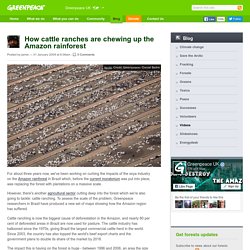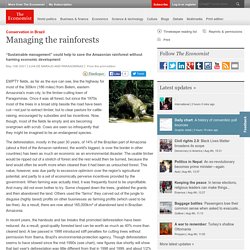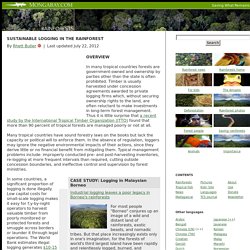

Amazon Deforestation Takes a Turn for the Worse. Until recently, Brazil stood out as a hopeful outlier in the plague of deforestation.

Between 1990 and 2010 clearing of tropical forests increased 62 percent worldwide, but in Brazil, such destruction plummeted from 2004 to 2011, in part because of tough environmental regulations and a ban on the sale of soybeans grown on rain-forest-cleared land. Since August 2014, however, tree cutting more than doubled in the country compared with the same period a year earlier, according to a satellite analysis released this spring by the independent research institution Imazon.
The report may signal a new round of challenges facing the world's largest rain forest. Deforestation and the impact on Amazon tribes. How cattle ranches are chewing up the Amazon rainforest. For about three years now, we've been working on curbing the impacts of the soya industry on the Amazon rainforest in Brazil which, before the current moratorium was put into place, was replacing the forest with plantations on a massive scale.

However, there's another agricultural sector cutting deep into the forest which we're also going to tackle: cattle ranching. To assess the scale of the problem, Greenpeace researchers in Brazil have produced a new set of maps showing how the Amazon region has suffered. Cattle ranching is now the biggest cause of deforestation in the Amazon, and nearly 80 per cent of deforested areas in Brazil are now used for pasture.
The cattle industry has ballooned since the 1970s, giving Brazil the largest commercial cattle herd in the world. Since 2003, the country has also topped the world's beef export charts and the government plans to double its share of the market by 2018. Amazon clearance for agriculture is 'economic own goal' for Brazil. Brazil is at risk of scoring an economic own goal if it continues clearing Amazon forest for herding and soya production, according to a new study that has potential implications for global food security.

In recent decades, the conversion of vast tracts of the Amazon into pastures and farm fields has boosted the national economy and played a major role in meeting rising world demand for beef and grain, particularly soyabeans – for which Brazil overtook the US this year as the number one supplier. But researchers say the economic and agricultural gains are in danger of slipping into reverse because the loss of forest is reducing rainfall, raising temperatures and causing other malign feedbacks on the regional climate. "The more agriculture expands in the Amazon, the less productive it will become … In this situation, we all lose," warns the paper by Brazilian and US scientists that is published on Friday in the journal Environmental Research Letters.
Managing the Amazon forests. We want the Amazon rainforest to be worth more standing than cut down.

Timber can provide a valuable source of income - but it needs to be harvested sustainably, which means forests must be well-managed. Why we’re involved It’s possible to harvest trees for timber selectively without permanently damaging the natural rainforest environment - and it’s much better than clearing the forest for agriculture and other land uses. But in the vastness of the Amazon, it’s not always clear who the land belongs to. Explicit cookie consent. EMPTY fields, as far as the eye can see, line the highway for most of the 300km (186 miles) from Belem, eastern Amazonia's main city, to the timber-cutting town of Paragominas.

Once it was all forest, but since the 1970s most of the trees in a broad strip beside the road have been cut—not just to extract timber, but to clear pasture for cattle-raising, encouraged by subsidies and tax incentives. Now, though, most of the fields lie empty and are becoming overgrown with scrub. Cows are seen so infrequently that they might be imagined to be an endangered species. The deforestation, mostly in the past 30 years, of 14% of the Brazilian part of Amazonia (about a third of the Amazon rainforest, the world's biggest, is over the border in other countries) has been as much an economic as an environmental disaster.
In recent years, the handouts and tax breaks that promoted deforestation have been reduced. Sustainable Logging in the Rainforest. In many tropical countries forests are government-owned and ownership by parties other than the state is often prohibited.

Timber is usually harvested under concession agreements awarded to private logging firms which, without securing ownership rights to the land, are often reluctant to make investments in long-term forest management. Thus it is little surprise that a recent study by the International Tropical Timber Organization (ITTO) found that more than 90 percent of tropical forests are managed poorly or not at all. Many tropical countries have sound forestry laws on the books but lack the capacity or political will to enforce them. In the absence of regulation, loggers may ignore the negative environmental impacts of their actions, since they derive little or no financial benefit from mitigating them. "Sustainable Development in the Amazon"
"Sustainable Development in the Amazon" Virtual Field Trip - Amazon Rainforest. Tropical Rainforest Adaptations. Tropical Rainforest Adaptations.